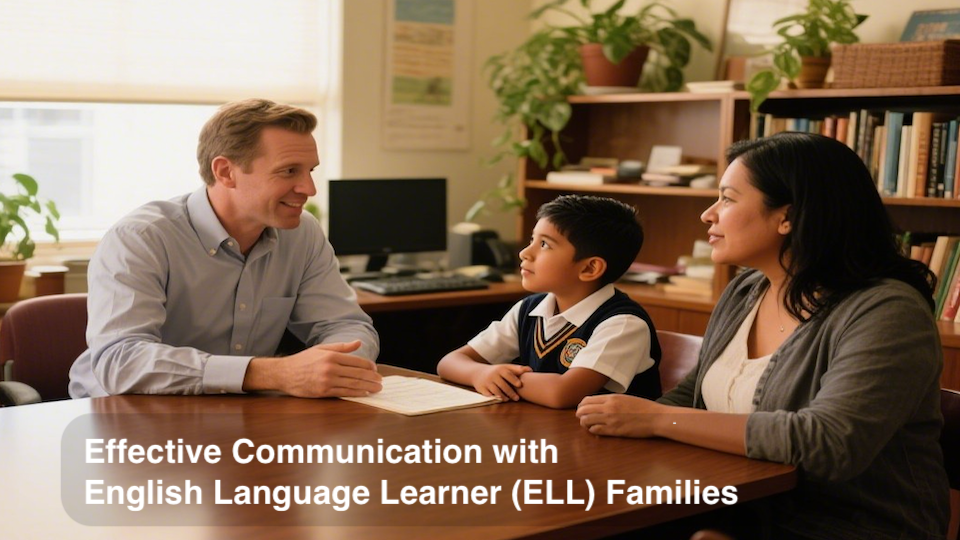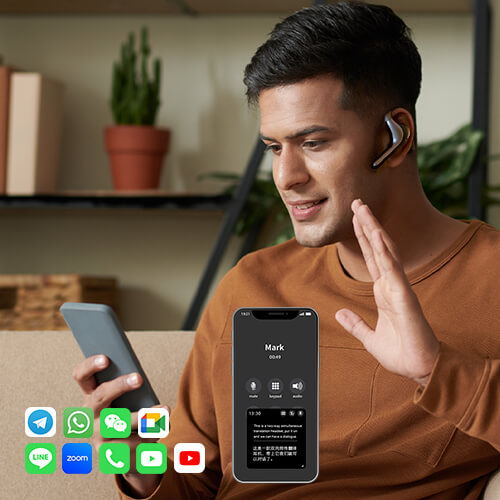
Effective Communication with English Language Learner (ELL) Families
In this day and age of diverse education, communication between schools and ELL families is not nice to have but necessary for student success. As educators we need to acknowledge the challenges these families face and implement ways to get them fully engaged in their child’s education. This blog will explore 8 ways schools can communicate better with ELL families to create a more inclusive and supportive learning environment for all students.
Foundations of Communication
Keeping Contact Info Current
Maintaining accurate contact information for ELL families is the foundation of effective communication. Accurate contact information is the foundation of communication with ELL families. Schools must prioritize collecting and updating phone numbers, email addresses and mailing addresses.
- Multilingual Updates: Send emergency contact forms or update requests in families’ native languages, with online, paper or phone options.
- Clear Communication: Explain why current info is important, especially for emergencies or critical updates, to encourage compliance.
- Community Partnerships: If traditional methods fail, connect with community organizations, faith-based groups or other families to verify contact info.
- Digital Equity: Partner with libraries or non-profits to provide Wi-Fi hotspots or devices so families can receive and respond to communications.
Tip: Create a user-friendly online portal where families can update their contact information and access important school resources. This portal should be accessible in multiple languages and include features such as reminders for upcoming school events and deadlines.
Preferred Communication Methods
Different families may prefer different modes of communication. Knowing how ELL families prefer to communicate enhances outreach. Schools should offer multiple channels and use data to refine.
- Phone Calls: Ideal for real-time, verbal communication, especially for families with limited internet access. Google Voice maintains professional boundaries.
- Text Messaging: Quick updates or reminders. WhatsApp allows group messaging in native languages.
- Email and Online Tools: Share resources but less effective if families have no digital access. Supplement with other methods.
- Social Media: Private Facebook groups or messaging apps for informal, bilingual updates. Ensure privacy and security compliance.
- Data-Driven Refinement: Track response rates (e.g. text vs. email) and survey families to prioritize the most effective channels.
Overcoming Language Barriers
Language barriers can significantly hinder communication between schools and ELL families. Language access is a legal requirement and a cornerstone of communication. Schools must use human and technological resources to be clear.
- Bilingual Staff and Interpreters: Use interpreters, family liaisons or bilingual paraprofessionals for cultural insights and accurate translations. Know their schedules and support their work with resources.
- AI Translation Tools: Apps like Talking Points offer real-time text translation, while AI chatbots can handle routine questions in multiple languages, supplementing human interpreters. Devices such as translation earbuds further enhance communication by providing real-time spoken language translation in various settings.
- Legal Requirements: Send translated info on schedules, assignments, ELL services, special ed and learning support so families know their rights.
- Tech Limitations: Apps are useful but no substitute for human interpreters.
Remember: While technology can be helpful, it's essential to verify the accuracy of translations, especially for critical information. Schools should have a process in place for reviewing translated materials to ensure they convey the intended message accurately.
Related Reading: Franklin Township Schools Use Timekettle Translator Earbuds to Overcome Language Barriers
Building Inclusive Relationships

Training Staff in Cultural Competence
Cultural competence is essential for meaningful engagement with ELL families. Schools must invest in professional development to foster understanding and humility.
- Understanding Differences: Train staff on cultural traditions and beliefs to create inclusive environments.
- Mitigating Biases: Use self-reflection, perspective-taking, and bias awareness training to ensure equitable interactions.
- Intercultural Skills: Practice navigating nonverbal cues and communication styles through role-playing and case studies.
- Cultural Humility: Encourage lifelong learning and openness to families’ perspectives.
- Responsive Practices: Incorporate culturally relevant materials and examples in classrooms.
Ongoing dialogue, affinity groups, and mentorship programs can further support educators in sharing best practices and addressing challenges.
Engaging ELL Families and Students
Empowering ELL families and students strengthens school-community bonds and promotes inclusivity.
- Welcoming Environment: Display multilingual signs, create comfortable gathering spaces, and train staff to greet families warmly.
- Cultural Events: Host multicultural celebrations or potlucks to honor diversity and invite families to share their traditions.
- Student Ambassadors: Engage ELL students to translate simple messages or share experiences at events, bridging gaps between schools and families.
- Policy Co-Creation: Invite families to join advisory councils or focus groups to shape communication strategies, ensuring their voices are heard.
- Trauma-Informed Communication: Use empathetic language and connect families to mental health resources in their native languages, recognizing potential challenges like immigration or displacement.
Creative and Sustainable Strategies
Adapting Innovative Approaches
The COVID-19 pandemic spurred creative communication strategies that remain relevant for long-term use.
- Video Messages: Record personalized greetings or updates in families’ home languages to build connection.
- Social Media Groups: Use private groups on platforms like WhatsApp or Facebook for bilingual updates and two-way communication.
- Multilingual Packets: Deliver translated learning materials to families without digital access.
- Food Delivery Notes: Attach teacher contact information to meal deliveries for personal outreach.
- Postcard Check-Ins: Mail brief, multilingual postcards to show support and availability.
- Phone Trees: Collaborate with community liaisons to relay messages through trusted voices.
These strategies can be sustained to maintain personal, accessible communication year-round.
Supporting Social-Emotional Needs
Many ELL families face social-emotional challenges, particularly refugees or immigrants. Schools should adopt trauma-informed practices.
- Empathetic Messaging: Use reassuring, inclusive language in all communications.
- Resource Connections: Share information on mental health services, parenting support, or community resources in native languages.
- Feedback Loops: Regularly seek family input to ensure communications meet their emotional and practical needs.
Systemic Support for Success
Securing Administrator Support
Administrators play a critical role in enabling effective ELL communication by allocating resources and adjusting policies.
- Time Allocation: Provide release time or adjust schedules to allow educators to focus on family outreach.
- Resource Investment: Fund interpreters, translation software, and multilingual materials.
- Professional Development: Offer training on cultural competence and communication strategies.
- Clear Protocols: Establish expectations for ELL family engagement.
- Stakeholder Input: Consult educators, bilingual staff, and families to identify barriers and solutions.
Advocating for Broader Change
While school-level efforts are vital, systemic change ensures sustainability.
- District Policies: Advocate for funding for interpreters, technology, and training across all schools.
- State-Level Support: Push for policies that prioritize language access and cultural competence in education.
- Community Collaboration: Partner with local organizations to expand resources and outreach.
Conclusion
Communicate with ELL families and your school becomes an inclusive, supportive community where students flourish. Keep contact info up to date, respect communication preferences, bridge language gaps, and be culturally competent and you’ll build relationships that last. Creative strategies and trauma informed practices will boost engagement and administrative and systemic support will make it sustainable. Start small, send a multilingual welcome message today, and ask for ongoing feedback from families to refine your approach, so every family feels heard and powerful.
Here is the checklist for Effective Communication with ELL Families:
| Strategy Category | Key Approaches |
|---|---|
| Foundations of Communication | - Keep contact info current (phone, email, address) - Multilingual forms and updates - Explain importance of accurate info - Community help to verify info - Partner for digital access |
| Preferred Communication Methods | - Phone calls (e.g. Google Voice) - Text messaging (e.g. WhatsApp) - Email and online platforms - Social media groups - Use data to refine methods |
| Overcoming Language Barriers | - Bilingual staff and interpreters - AI translation tools (apps, chatbots, translation earbuds) - Legally required translations - Acknowledge tech limitations |
| Building Inclusive Relationships | - Train staff in cultural traditions - Address bias through reflection - Practice intercultural skills - Promote cultural humility - Use culturally relevant materials - Support dialogue and mentorship |
| Engaging ELL Families and Students | - Create welcoming environments - Host cultural events - Empower student ambassadors - Involve families in advisory roles - Use trauma-informed language |
| Creative & Sustainable Strategies | - Record video messages in home languages - Use social media groups for bilingual updates - Deliver multilingual packets - Attach info to meal deliveries - Send multilingual postcards - Use phone trees |
| Supporting Social-Emotional Needs | - Use empathetic messaging - Share mental health and parenting resources - Set up feedback loops |
| Systemic Support for Success | - Allocate staff time for outreach - Invest in interpreters and tools - Provide staff training - Define engagement protocols - Involve stakeholders - Advocate for district/state support - Collaborate with community groups |






















